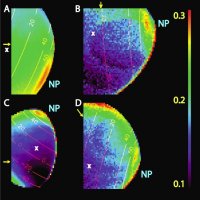Evidence for Polar Ethane Cloud on Titan
 |
|
VIMS images of Titan at 2.8 μm on four dates, showing the presence of a cloud structure (red colour) at 51° - 68° N latitudes |
This is in contrast with the south polar region, where clouds are currently formed by summer heating of Titan's surface, resulting in evaporation and subsequent condensation of methane.
The vast cloud imaged by VIMS, covers the latitudes between 51° and 68° N. Because the Sun currently doesn't illuminate the north polar region and no reflectance measurements can be made there, the cloud can not yet be confirmed to extend to latitudes above 68° N.
The ethane cloud is diffuse, shows no variability on small (1-hour) timescales, and is very uniform. VIMS took spectral images over the wavelength range 0.35 to 5.1 μm from which the altitude range of the cloud was determined to be 30 to 50 km.
To determine the composition of the cloud, Griffith et al. looked at multiple parameters: optical depth, particle sizes, latitude and altitude position correlation with general circulation model for northern winter, optical appearance (albedo) at different wavelengths. They found the parameters to be only consistent with ethane, excluding other possibilities such as haze particles and methane.
Lack of Ethane at Lower Latitudes
Ethane is continuously produced in Titan's atmosphere by the photo-dissociation of methane by solar UV radiation. Models of Titan's atmosphere and chemistry predicted the existence of large amounts of ethane both in vast clouds at all latitudes and in large seas on the moon's surface.
Observations of Titan have proven this not to be the case. The newly discovered cloud implies ethane to preferentially reside at high latitudes, partly explaining the lack of ethane lakes at lower latitudes.
Polar Reservoirs
During the winter, around the poles, temperatures are expected to drop below the freezing point of ethane (90.3K) and could allow for the formation of polar ice caps. These ice caps, however, have not yet been directly observed, as the current illumination conditions don't allow reflectance measurements of the north pole by VIMS.
Images of the south polar surface (which is currently in summer) suggest the existence of flow features that could be associated with smaller amounts of surface ice. Further imaging and radar observations will be performed during future flybys of Titan, that will contribute in the search for ethane on the surface in the polar regions.

